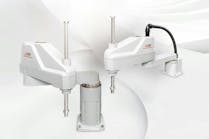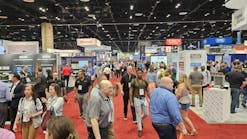Although air is not cooled by movement alone, it can create a cooling sensation as it passes over a person's skin. The proper use of air movement, then, can increase occupant satisfaction. It also can improve energy efficiency, as substantial savings can be realized by destratifying heated air in spaces with high ceilings during cooler months.
This article discusses how large circulator fans can be used to improve comfort and save energy in indoor environments. It also discusses occupants' expectations of thermal comfort in naturally conditioned and air-conditioned spaces. Lastly, it briefly discusses the benefits of air movement in air-conditioned spaces.
OPERATIVE TEMPERATURE
Operative temperature, top, is defined in ANSI/ASHRAE Standard 55-2004, Thermal Environmental Conditions for Human Occupancy, as the uniform temperature of an imaginary black enclosure in which an occupant exchanges the same amount of heat by radiation and convection as in an actual non-uniform environment. Standard 55-2004 provides an equation for calculating operative temperature:
top = (tdb + tr) ÷ 2
where:
tdb = dry-bulb air temperature, degrees Fahrenheit
tr = mean radiant temperature, degrees Fahrenheit
Mean radiant temperature is measured with a globe thermometer, while dry-bulb air temperature is measured with a regular thermometer.
ADAPTIVE THERMAL COMFORT
ASHRAE Standard 55-2004 includes a graph of indoor operative temperatures that would satisfy 80 percent and 90 percent of the occupants in a naturally conditioned space.
In a naturally conditioned space, air speed is used to achieve thermal comfort without refrigerative or evaporative cooling. For example, with a mean outdoor dry-bulb air temperature of 84.9°F in August, the indoor operative-temperature range for 80-percent occupant satisfaction in Houston is 74°F to 87°F (Figure 1). The average maximum dry-bulb air temperature in August in Houston is 94°F and occurs around 3 p.m., with relative humidity 65 percent.
DETERMINING THE ELEVATED AIR SPEED NEEDED TO IMPROVE COMFORT
ASHRAE Standard 55-2004 uses standard effective temperature (SET),1 calculated using Thermal Comfort Tool software (available for purchase at www.ashrae.org), to determine the elevated air speed needed to improve comfort. ASHRAE Handbook-Fundamentals2 defines SET as the air temperature of an isothermal environment at 50-percent RH in which a subject, wearing clothing standardized for the activity concerned, has the same heat stress (skin temperature) and thermoregulatory strain (skin wettedness) as in an actual environment. SET can account for:
- Air temperature.
- Mean radiant temperature.
- Humidity.
- Air movement.
- Metabolic rate.
- Clothing insulation.
The first step in determining the elevated air speed needed for thermal comfort in a naturally conditioned space in Houston in August is to determine the preferred air speed and clothing-insulation value (Clo) for 87°F, the upper limit of operative temperature for the comfort zone. From figures 2 and 3, the preferred air speed is 52 fpm, and the preferred clothing-insulation value is 0.58 Clo. (Zero Clo corresponds to a naked person; 1 Clo corresponds to a person wearing a typical business suit.)
A warehouse supervisor sitting on a stool checking paperwork on a clipboard represents a metabolic rate of 1.1 met. The clothing-insulation value of a T-shirt, men's briefs, walking shorts, ankle socks, and shoes is about 0.31. (Insulation values of typical clothing are provided in Appendix B of ASHRAE Standard 55-2004.)
Using Thermal Comfort Tool, set the operative temperature at 87°F. Then, set the typical adaptive-thermal-comfort survey reference values of 50-percent RH and 1.1 met and the preferred values of 0.58 Clo and 52-fpm air speed, and calculate SET. SET for the upper limit of the thermal-comfort zone will be 85.2°F.
Next, using Thermal Comfort Tool, enter the following data, which represent the average maximum thermal conditions for the example of the warehouse supervisor in Houston in August:
- Air temperature: 94°F.
- Mean radiant temperature: 89°F.
- Humidity: 65 percent.
- Metabolic rate: 1.1 met.
- Clothing insulation: 0.31 Clo.
By increasing local air speed to 224 fpm in Thermal Comfort Tool, SET falls to 85.2°F, the upper limit of the adaptive-thermal-comfort zone for Houston in August.
BUILDING-ENVELOPE AND VENTILATION CONSIDERATIONS
Insulation should ensure that the internal surface temperature of walls and ceilings is less than 9°F above indoor-air temperature.4 In hot climates, a barrier should be provided on the underside of a roof to avoid radiant gain from the roof to occupants. A floor slab laid on fill in Houston, on the other hand, should have a surface temperature of around 72°F during August. At this temperature, it will provide some radiant cooling for occupants. Occupants can lose heat by radiation and conduction to the slab at this temperature. With appropriate ventilation of the space, indoor-air temperature will be equal to outdoor-air temperature.2
COMFORT IN AIR-CONDITIONED SPACES
Consider an air-conditioned space in which, during summer:
-
Relative humidity is controlled to around 50 percent.
-
Air movement is less than 40 fpm.
-
Occupants are wearing typical summer dress (0.5 Clo).
-
Occupants have a sedentary metabolic rate of 1 met.
According to ASHRAE Standard 55-2004, the range of temperatures to satisfy 80 percent of the occupants in such a space is 76.5°F to 81.3°F (a difference of 4.8°F).
DIFFERENT COMFORT EXPECTATIONS
It is important to appreciate the difference between the comfort expectations of occupants in air-conditioned spaces and the comfort expectations of occupants in naturally conditioned spaces. In Houston in August, the comfort expectation for an air-conditioned space is 76.5°F to 81.3°F, while for a naturally conditioned space, it is 73.2°F to 85.8°F.
TEMPERATURE OFFSETS
With Thermal Comfort Tool software, the relevant output for air-conditioned spaces is predicted mean vote (PMV). The PMV needed to satisfy 80 percent of the occupants in an air-conditioned space is between -0.5 and +0.5.
Temperature offsets from elevated air speeds can be obtained by setting air temperature at 77°F. The other reference settings for Thermal Comfort Tool are:
-
Relative humidity: 50 percent.
-
Metabolic rate: 1 met.
-
Clothing insulation: 0.5 Clo.
-
Air speed: 30 fpm.
The dry-bulb-air-temperature setting, then, is increased until the PMV is +0.5, the upper limit of the comfort zone to satisfy 80 percent of occupants. The difference between 77°F and the temperature setting at a PMV of +0.5 is the temperature offset.
ESTIMATING COOLING-ENERGY SAVINGS FROM TEMPERATURE OFFSETS
Facility-maintenance engineers at Travis Air Force Base in California claim that turning up the thermostat on air-conditioning equipment 2°F reduces cooling operating costs by 8 percent (4 percent per degree Fahrenheit).5 Using a savings rate of, say, 3 percent per degree Fahrenheit to allow for fan energy on a 4.7°F temperature offset provides a net savings of 14 percent.
In spaces characterized by non-sedentary activity, such as gymnasiums, elevated air speeds of up to 315 fpm can provide temperature offsets of up to 6.9°F. The potential energy reduction from a 6.9°F temperature offset using a savings rate of 3 percent per degree Fahrenheit is 21 percent. A 24-ft-diameter ceiling fan, operating at a speed of 30 rpm using 0.63 kw of electricity, can provide a mean air speed of 315 fpm near floor level over an area of 7,844 sq ft (0.08 w per square foot).
DESTRATIFICATION SAVINGS DURING COOLER MONTHS
When a space is heated during cooler months, hotter air rises toward the ceiling, stratifying with a significant temperature gradient — typically, 0.75°F per foot from floor to ceiling. In a space over 10-ft high, heat energy above head height is wasted, as it does not contribute to occupant thermal comfort in the occupied zone. Thorough mixing of this hotter air with cooler air (destratification) results in a uniform air temperature throughout the space.6 Typically, 10 percent of heating energy is saved for each 10 ft of floor-to-ceiling height.
Approximately half of the air in a space needs to be circulated every hour for effective destratification. Twenty-four-foot-diameter circulator fans set at low speed (6.9 rpm) offer much greater aerodynamic efficiency (up to 669 cfm per watt) than smaller fans, delivering 98,940 cfm. Five-foot-diameter fans operating at 300 rpm (301 cfm per watt) deliver 43,878 cfm.
DESTRATIFICATION IN AIR-CONDITIONED SPACES
HVAC engineers often have difficulty balancing air-conditioning systems. Large circulator ceiling fans can mix the air in air-conditioned spaces to a uniform temperature and eliminate system-balancing problems. Large circulator ceiling fans also can serve as the first method of cooling in milder climates, delaying the startup of an HVAC system for substantial energy savings.
CONCLUSION
Energy consumption will be a concern of business owners as long as heating and cooling costs continue to fluctuate. The need to control costs, however, must be balanced with the need to maintain comfort, thus, ensuring high productivity and occupant satisfaction. With large circulator fans, higher rates of efficiency can be achieved than with HVAC systems alone. In some cases, large circulator fans even can eliminate the need for air conditioning. When air conditioning is required, however, large circulator fans can reduce the load on an HVAC system and eliminate the need for ductwork. With proper air movement, desired occupant comfort and reduced energy consumption can be achieved for any space.
REFERENCES
-
Aynsley, R. (2007, November). Circulating fans for summer and winter comfort and indoor energy efficiency (vol. 1: TEC 25). BEDP Environment Design Guide. Melbourne, Victoria, Australia: Australian Council of Built Environment Design Professions.
-
ASHRAE. (2005). ASHRAE handbook-fundamentals. Atlanta: American Society of Heating, Refrigerating and Air-Conditioning Engineers.
-
De Dear, R.J., & Brager, G.S. (2001). The adaptive model of thermal comfort and energy conservation in the built environment. International Journal of Biometeorology, 45, 100-108.
-
Koenigsberger, O.H., & Lynn, R. (1965). Roofs in the warm humid tropics. London: Lund, Humphries.
-
Feldpausch, N. (2006, June 2). Efficient thermostat settings saves energy, base money. Air Force Print News Today. Retrieved from http://public.travis.amc.af.mil/news/story_print.asp?storyID=123021158
-
Aynsley, R. (2005). Temperature profiles and winter destratification energy savings. Ecolibrium, 4, 18-23.
Richard Aynsley, PhD, is director of research and development for Big Ass Fans. Over the last 38 years, he has conducted research and consulting in the areas of building science, energy efficiency, and building aerodynamics for commercial and government clients in the United States, Australia, and New Zealand. He has a bachelor's degree in architecture from The University of New South Wales (UNSW) in Sydney, Australia; a master's degree in architectural engineering from The Pennsylvania State University; and a doctorate in bluff-body aerodynamics from UNSW.








